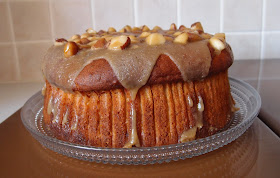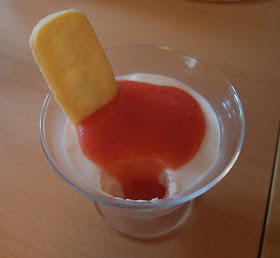Time for a delve into history corner and, for this visit, I’m
baking from “Isobel’s Home Cookery” from 1916.
Isobel’s Home Cookery was a monthly publication and, at the end of the
year, a bound volume was produced, which is what I have.
1916 was slap bang in the middle of World War 1 and, while
Britain didn’t have rationing until the very end of the war, care was taken to
avoid waste and flamboyance in recipes.
I chose brown cake because it seemed such an unglamorous name
for what is effectively a chocolate sponge sandwich. Unusually, the recipe requires you to make
chocolate milk and this provides not only the flavour, but also most of the
moisture as the recipe uses only one egg.
For a modern version of this cake I would expect three eggs.
The cake rather divided my eatership –some finding it too
dense and cloying in texture.
Interestingly, they don’t like brownies either for the same reason. I do like brownies and think that this cake
is similar to a squidgy brownie...which is no bad thing, but don’t make it
expecting a light crumbly sponge.
The icing is particularly austere in that it contains cocoa,
sugar and water. No buttercream
here! Surprisingly, it tastes very good
and rich – a cocoa hit for the chocolate lovers out there.
The patriotic biscuits are a light gingerbread which manages to be crunchy and chewy at the same time. The only patriotic element seems to be using red, white and blue sprinkles but, as I didn’t have any, I opted for pastel shades.
What I love about old recipe books is the insight they give you into ordinary people’s lives and views; the hot issues and health scares of the day. Here are some of my favourite examples:
I had never considered that the piece of cheddar lurking in
my fridge was plotting to do me harm!
In an age where we’re bombarded with statistics on childhood
obesity and TV chefs are launching crusades about poor school lunches, I find
it refreshing (and a tiny bit comforting, if I’m honest) that there was an age
when mothers were advised to give their children sugar, especially in cake
form.
This is less than 100 years ago but look at how old age is
portrayed. I’d love to know how old the
lady was in this photo and then compare her to women of her age nowadays – I think
we’d be shocked.
This is one of my favourites. March is the month when youngsters are apt to
get ‘out of sorts’. I’m sure with this
Mrs Danvers-esque woman
bringing them trays they’ll be motivated to get well and out of her clutches in
no time!
While most of the book focuses on running the home and
looking after the family, some sections are rather more poignant, like this one
about husbands coming home from the front.
Wives are recommended to give their husband food they wouldn’t get in
the trenches and pastry is suggested as an achievable luxury.
There is a section on cakes and biscuits you can always have on hand so that you can offer unexpected visitors something a little more exciting than bread and butter. What I love is the dress the lady is wearing. If I have unexpected visitors (which I don’t because anyone who knows me knows better than to turn up unannounced!) they will find me in slippers, jogging bottoms and a t-shirt. This lady looks rather more groomed!
This boy is pale and thin because he has the same kind of sandwiches every day! Not fair. I had ham sandwiches practically every day at school – how come the affliction of thinness passed me by? I think I will stick with ham sandwiches rather than the suggested raisin and nut sandwiches. What next – ham flapjacks?
I end on a note of caution and advice – feed up when you feel run down. Be safe out there people......
Ingredients
for the brown cake
For the
cake:
285ml / ½ pint milk
45g / 1 ½ oz cocoa, mixed with enough cold water to make it into thin cream – I added 8 tablespoons
115g / 4oz unsalted butter, at room temperature
170g / 6oz brown sugar
1 egg
½ teaspoon vanilla extract
340g / 12oz self raising flour
45g / 1 ½ oz cocoa, mixed with enough cold water to make it into thin cream – I added 8 tablespoons
115g / 4oz unsalted butter, at room temperature
170g / 6oz brown sugar
1 egg
½ teaspoon vanilla extract
340g / 12oz self raising flour
For the
icing:
Equal quantities of cocoa and icing sugar – I used 8
tablespoons of each
Enough boiling water to make a glossy icing
Enough boiling water to make a glossy icing
Method
for the brown cake
Preheat the oven to 180°C/fan oven 160°C/350°F/gas mark 4.
Line two 20cm round loose bottomed sandwich tins with baking
paper.
Place the milk in a small saucepan and bring the milk to the
boil.
While the milk is heating, mix together the cocoa with
enough cold water to make it the consistency of thin cream. I found this to take 8 tablespoons.
When the milk boils, remove from the heat and stir in the
cocoa.
Put to one side to cool.
In a mixing bowl beat together the butter and sugar until
smooth and well combined.
Beat in the egg and vanilla.
Stir in half the flour along with half the cocoa milk.
Repeat with the remainder.
Don’t worry – the batter will be runny.
Ladle the batter into the two prepare tins.
Bake for 20-25 minutes or until a skewer inserted into the
cakes comes out clean.
Place the tins on a wire rack to cool and de-tin the cakes
as soon as you can safely handle the tins.
Leave the sponges to cool completely before storing in an
airtight container.
Now make the icing: Place an equal quantity of cocoa and
icing sugar into a bowl – I used 8 tablespoons of each as I only planned to
sandwich the cakes, not decorate the top.
Add boiling water, a teaspoon at a time, and beat into the
dry ingredients.
Keep adding tiny amounts of boiling water – the icing should
be glossy and thick. Adding too much
water will make it dull. (Mine took 9 teaspoons in the end)
Place one sponge on a serving plate and spread the icing
over the top.
Place the other sponge on top.
Bask in the glory of the wonderful thing you have created.
Eat.
Ingredients
for the patriotic biscuits
57g / 2oz unsalted butter, at room temperature
170g / 6oz plain flour
1 teaspoon ground ginger
57g / 2oz light brown sugar – the recipe called for ‘moist sugar’ which I think is dark brown sugar i.e. sticky and treacly
115g / ¼ lb golden syrup
170g / 6oz plain flour
1 teaspoon ground ginger
57g / 2oz light brown sugar – the recipe called for ‘moist sugar’ which I think is dark brown sugar i.e. sticky and treacly
115g / ¼ lb golden syrup
To decorate: 1 egg white and hundreds and thousands (ideally
red, white and blue)
Method
for the patriotic biscuits
Preheat the oven to 200°C/fan oven 180°C/400°F/gas mark 6.
Line two baking sheets with baking paper or non stick foil.
Beat the butter until it is soft and creamy.
Add the flour and beat until the mixture resembles
breadcrumbs.
Stir in the ginger and sugar.
Stir in the golden syrup and bring the mixture into a firm,
moist dough.
Roll out between two sheets of clingfilm and aim for a
thickness of approx 0.5cm.
Using a 7cm round cutter I got 18 biscuits. The dough re-rolls easily but when rolled out
the golden syrup starts to rise to the surface so work quickly.
Place the biscuits on the prepared sheet (they don’t spread
that much) and bake for 10 minutes or until a darker golden colour.
Leave to cool for 5 minutes when out of the oven.
Brush with beaten egg white and sprinkle with hundreds and
thousands.
Bask in the glory of the wonderful thing you have created.
Eat.











































